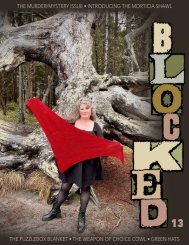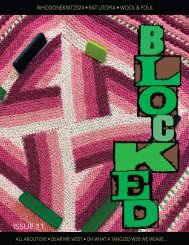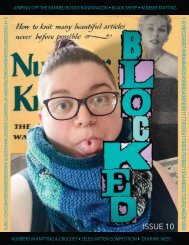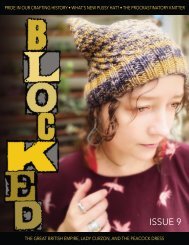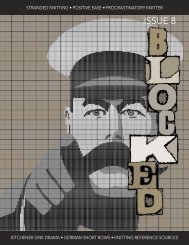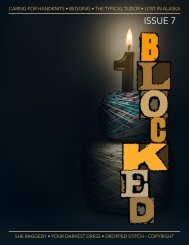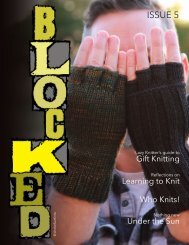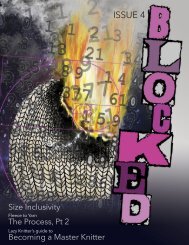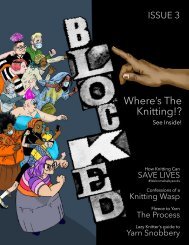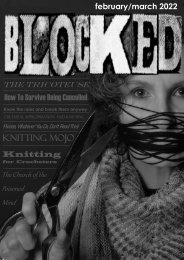You also want an ePaper? Increase the reach of your titles
YUMPU automatically turns print PDFs into web optimized ePapers that Google loves.
Book Reviews... Continued...<br />
Of the four books I reviewed, and the entire Elizabeth<br />
Zimmermann series, hands down, no questions asked, the<br />
most informative and detailed book is Sweater Design in<br />
Plain English (ed. 1 Righetti, 1992; ed 2. Righetti & Shaw,<br />
2011). This book is out of print, and I am so glad I pursued<br />
a copy of the second edition via Interlibrary Loan. As of 27<br />
December 2023, there are six used copies of the first<br />
edition for sale on Amazon at ranging from $24.49 to<br />
$71.05, that can be found at:<br />
https://a.co/d/0UWneEC<br />
There were no copies of the second edition available<br />
that I could locate. I have asked Santa already to please<br />
bring me a copy of this book as I want to add this to my<br />
knitting reference bookshelf.<br />
Maggie Righetti is the author of<br />
Knitting in Plain English, a well-respected<br />
book on knitting techniques.<br />
Sweater Design in Plain English brings<br />
together all aspects of sweater design<br />
to help you make the best decisions<br />
along the way in designing and knitting<br />
a sweater. Maggie Righetti is an<br />
experienced knitter and custom knitwear<br />
designer. She has been active in<br />
knitting guilds and gained an immense<br />
body of knowledge about<br />
what can go right and wrong when<br />
knitting. In addition, Righetti learned<br />
quite a bit about the human body<br />
from life drawing and color from art<br />
classes. The book contains three useful sections: “Before<br />
You Begin, “Doing It: The Actual Designs,” and “Appendices.”<br />
The first section, “Before You Begin,” is extremely informative<br />
as she uses her knitting, design, human body,<br />
and color theory knowledge to explain to you each aspect<br />
of sweater design. The 18 chapters in the first section deal<br />
with one topic at a time and make for quick reference if<br />
you want to reread a section. All chapters are informative,<br />
yet not too long or detailed, compelling, and the information<br />
learned builds upon the information in the previous<br />
chapter. “Before You Begin” contains 18 chapters,<br />
including chapters on:<br />
• Overcoming Your Fears<br />
• Avoiding Costly Mistakes<br />
• Yarn and how it behaves<br />
• Body shapes<br />
• How to measure<br />
26<br />
• Flattering designs for body shapes<br />
• Achieving the right marriage of fiber, fabric,<br />
and fashion<br />
• How pattern stitches behave<br />
• Color selection, including color theory<br />
supporting color selection<br />
• Yarn quantities<br />
• Gauge<br />
• Steps to design a sweater<br />
• Arithmetic of knitting<br />
The second section, “Doing It: The Actual Designs,”<br />
provides 13 separate sweater designs, with each sweater<br />
design building your design skills as you progress through<br />
each sweater design. All but one<br />
sweater are knit flat and sewn together<br />
and knit from the bottom up. One<br />
sweater is knit in the round, top down.<br />
Righetti provides thorough explanations<br />
of the positive and negative features<br />
of each design and how to work<br />
within those features. Righetti goes<br />
step by step for each of the 13 sweater<br />
designs. She selects a size and gauge,<br />
then walks you through how to make all<br />
the design decisions with each sweater<br />
design. This section is much more of a<br />
workbook, or template, for how to custom<br />
design each of these sweaters for<br />
yourself or your intended recipient. She<br />
provides the measurements needed for<br />
each sweater design and how to calculate the size of each<br />
piece. With those numbers, she provides a detailed explanation<br />
of how to calculate each number you need (stitch<br />
counts) along with detailed knitting instructions throughout<br />
the calculations. The “Personal Measurements Chart”<br />
and “Project Record Form,” both found in Part 3, will help<br />
you capture all these measurements and calculations.<br />
Continued on next page






